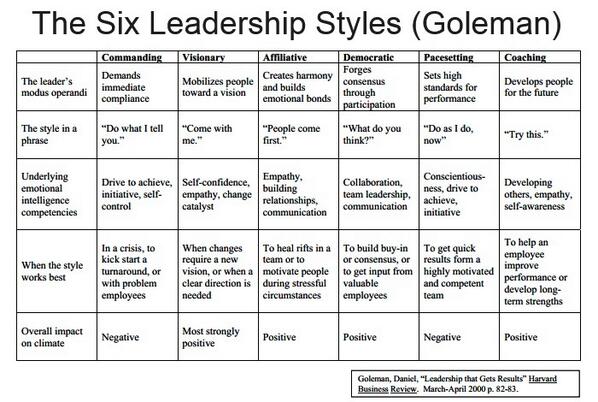What Are The 6 Management Styles Every Leader Should Know?
Daniel Goleman’S 6 Leadership Styles For Team Leaders
Keywords searched by users: What are the 6 management styles what are the 7 management styles?, leadership and management styles, management styles examples, management styles vs leadership styles, best management styles, 8 management styles, bad management styles, what is your management style
What Are The 6 Common Leadership Styles?
Leadership styles play a crucial role in shaping how individuals lead and manage teams or organizations effectively. There are six widely recognized leadership styles, each with its unique characteristics and approaches:
-
Transformational Leadership: Transformational leaders inspire and motivate their teams by setting high standards and encouraging innovation and personal growth among team members. They lead by example and focus on long-term goals.
-
Delegative Leadership: Delegative leaders entrust decision-making and responsibilities to their team members, allowing them autonomy in their roles. This style fosters individual growth and can be particularly effective when working with skilled and experienced team members.
-
Authoritative Leadership: Authoritative leaders provide clear direction and make decisions based on their expertise and vision. They are effective in situations where quick and decisive action is required, and team members seek guidance.
-
Transactional Leadership: Transactional leaders use a structured approach to management, setting clear expectations, rewards, and consequences for performance. This style is effective in maintaining order and ensuring that tasks are completed efficiently.
-
Participative Leadership: Participative leaders involve team members in decision-making processes and value their input. This approach promotes collaboration and generates a sense of ownership among team members.
-
Servant Leadership: Servant leaders prioritize the needs of their team members above their own. They focus on nurturing a supportive and empathetic environment, aiming to empower and uplift their team through selflessness and humility.
Understanding these various leadership styles is essential for leaders to adapt and choose the most suitable approach depending on the situation and the individuals they are working with. Each style has its merits, and effective leaders often employ a combination of these styles to achieve the best results in their leadership roles.
What Are The 7 Leadership Styles In Management?
Certainly, let’s rephrase and provide more comprehensive information about the seven leadership styles in management:
Leadership in management encompasses a spectrum of styles that leaders can adopt to guide their teams effectively. These seven primary leadership styles are essential to understanding the dynamics of leadership in various organizational settings:
-
Autocratic Leadership: This style involves a leader who makes decisions unilaterally, with little input from their team. They provide clear instructions and expect immediate compliance.
-
Pacesetting Leadership: Pacesetting leaders set high standards for themselves and their team members. They lead by example and expect everyone to meet these high expectations.
-
Transformational Leadership: Transformational leaders inspire and motivate their team members to achieve common goals. They focus on fostering personal growth, innovation, and positive change within the organization.
-
Coaching Leadership: Coaching leaders take a developmental approach. They provide guidance, mentorship, and support to help team members improve their skills and reach their full potential.
-
Democratic Leadership: This style emphasizes collaboration and decision-making by consensus. Leaders seek input from team members and involve them in the decision-making process.
-
Affiliative Leadership: Affiliative leaders prioritize building strong interpersonal relationships among team members. They create a harmonious work environment and prioritize team well-being.
-
Delegative Leadership: Delegative leaders entrust their team members with decision-making authority. They allow team members to take the lead in various tasks and projects.
Understanding these seven leadership styles can help leaders adapt their approach to different situations and effectively lead their teams towards success.
Summary 45 What are the 6 management styles


![PDF] Leadership Styles And Theories In An Effective Management Activity | Semantic Scholar Pdf] Leadership Styles And Theories In An Effective Management Activity | Semantic Scholar](https://d3i71xaburhd42.cloudfront.net/74619f635dcacbb148e0e6ef6b8fbc6e63a07506/4-Table2-1.png)


Categories: Found 29 What Are The 6 Management Styles
See more here: tfvp.org

Based on these two leadership types, management theorists Robert Blake and Jane Mouton identified five management styles: Impoverished Management, Produce-or-Perish Management, Middle-of-the-Road Management, Country Club Management, and Team Management.There are three broad categories of management styles: Autocratic, democratic and laissez-faire. Within these categories, there are specific subtypes of management styles, each with its own pros and cons.
- The 6 Hay-McBer management styles: Your style could be commanding, or it might be collaborative. …
- Directive/Coercive style. …
- Authoritative/Visionary style. …
- Affiliative style. …
- Participative/Democratic style. …
- Pacesetting style. …
- Coaching style.
- Transformational Leadership.
- Delegative Leadership.
- Authoritative Leadership.
- Transactional Leadership.
- Participative Leadership.
- Servant Leadership.
- Autocratic Leadership.
- Pacesetting Leadership.
- Transformational Leadership.
- Coaching Leadership.
- Democratic Leadership.
- Affiliative Leadership.
- Delegative Leadership.
Learn more about the topic What are the 6 management styles.
- Different management styles & how SMEs can use them
- The 6 Most Common Leadership Styles & How to Find Yours
- 7 Leadership Styles and How to Find Your Own – American Express
- The Blake Mouton Grid – Leading People and Producing Results
- 10 Types of Management Styles: Which One is the Best [2023]
- The 6 Goleman Leadership Styles: Which Is Yours? – Personio
See more: blog https://tfvp.org/category/science